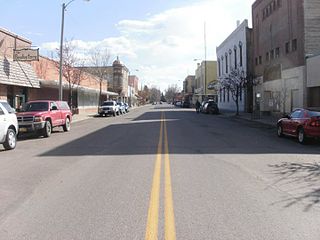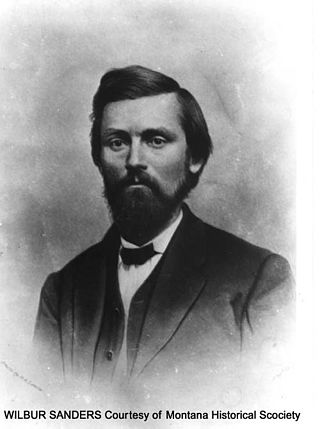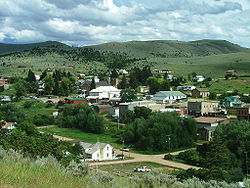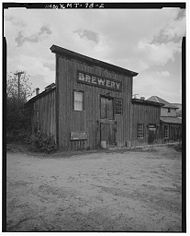
Helena is the capital city of the U.S. state of Montana and the seat of Lewis and Clark County.

Idaho City is a town in, and the county seat of, Boise County, Idaho, United States, located about 36 miles (58 km) northeast of Boise. The population was 485 at the 2010 census, up from 458 in 2000.

Pierce is a city in the northwest United States, located in Clearwater County, Idaho. The population was 508 at the 2010 census, down from 617 in 2000.

Dillon is a city in and the county seat of Beaverhead County, Montana, United States. The population was 3,880 at the 2020 census. The city was named for Sidney Dillon (1812–1892), president of Union Pacific Railroad.

Fort Benton is a city in and the county seat of Chouteau County, Montana, United States. Established in 1846, Fort Benton is the oldest continuously occupied settlement in Montana. Fort Benton was the most upstream navigable port on the Mississippi River System, and is considered "the world’s innermost port".

East Helena is a city in Lewis and Clark County, Montana, United States, approximately 5 miles (8 km) east of downtown Helena. The population was 1,944 at the 2020 census. It is part of the Helena Micropolitan Statistical Area, which includes all of Lewis and Clark and Jefferson counties; its population is 83,058 according to the 2020 Census.

Alder is a census-designated place (CDP) in Madison County, Montana, United States. The population was 86 at the 2020 census. The community takes its name from Alder Creek, the site of the second major gold discovery in Montana.

Bannack is a ghost town in Beaverhead County, Montana, United States, located on Grasshopper Creek, approximately 11 miles (18 km) upstream from where Grasshopper Creek joins with the Beaverhead River south of Dillon. Founded in 1862, the town is a National Historic Landmark managed by the state of Montana as Bannack State Park.

Henry Plummer was a prospector, lawman, and outlaw in the American West in the 1850s and 1860s, who was known to have killed several men. He was elected sheriff of what was then Bannack, Idaho Territory, in 1863 and served until 1864, during which period he was accused of being the leader of a "road agent" gang of outlaws known as the "Innocents," who preyed on shipments from what was then Virginia City, Idaho Territory to other areas. In response some leaders in Virginia City formed the Vigilance Committee of Alder Gulch and began to take action against Plummer's gang, gaining confessions from a couple of men they arrested in early January 1864. On January 10, 1864, Plummer and two associates were arrested in Bannack by a company of the Vigilantes and summarily hanged. Plummer was given a posthumous trial in 1993 which led to a mistrial. The jury was split 6–6.

Alder Gulch is a place in the Ruby River valley, in the U.S. state of Montana, where gold was discovered on May 26, 1863, by William Fairweather and a group of men including Barney Hughes, Thomas Cover, Henry Rodgers, Henry Edgar and Bill Sweeney who were returning to the gold fields of Grasshopper Creek, Bannack, Montana. They were on their way to Yellowstone Country from Bannack but were waylaid by a band of Crow Indians. After being ordered out of Crow hunting grounds, they crossed the East Slope of the Tobacco Root Mountains and camped for the night in Elk Park, where William "Bill" Fairweather and Henry Edgar discovered gold, while the remaining party was out hunting for meat. Agreeing to keep the new discovery quiet the group of miners returned to the town of Bannack for supplies. However, word leaked out about the new strike, and miners followed the Fairweather party out of town. The party stopped at the Point of Rocks, part way between Bannack and Alder Gulch, and established the Fairweather Mining District in a miners meeting. It was agreed that the discoverers were entitled to two claims and first choice. The first stampede of miners reached Alder Gulch June 6, 1863, and the population swelled to over 10,000 in less than 3 months. The "Fourteen Mile City" ran the length of the gulch, and included the towns of Junction City, Adobe Town, Nevada City, Central City, Virginia City, Montana, Bear Town, Highland, Pine Grove French Town, Hungry Hollow, and Summit. Upon arrival the miners lived in brush wickiups, dugouts and under overhanging rocks until cabins could be built. The first structure built in Virginia City was the Mechanical Bakery. Virginia City, and Nevada City were the centers of commerce during the height of the Alder Gulch gold rush. In the first year the area had over 10,000 people living there. Montana Territory was established in May 1864, and the first territorial capital was Bannack. The capital then moved to Virginia City, where it remained until 1875. The Alder Gulch diggings were the richest gold placer deposits ever discovered, and in three years $30,000,000 was taken from them, with $10,000,000 taken out in the first year. Nowadays, except during summertime, the streets of Virginia City are usually quiet and relatively few visitors find their way to the 16 ton granite monument that marks the spot of that incredible discovery of May 26, 1863.

Wilbur Fisk Sanders was a United States senator from Montana. A leading pioneer and a skilled lawyer, Sanders played a prominent role in the development of Montana Territory and the state's early political history.

The Bertrand was a steamboat which sank on April 1, 1865, while carrying cargo up the Missouri River to Virginia City, Montana Territory, after hitting a snag in the river north of Omaha, Nebraska. Half of its cargo was recovered during an excavation in 1968, more than 100 years later. Today, the artifacts are displayed in a museum at the DeSoto National Wildlife Refuge near Missouri Valley, Iowa. The display makes up the largest intact collection of Civil War-era artifacts in the United States, and are an invaluable time capsule of everyday life during that period.

The Virginia City Historic District is a National Historic Landmark District encompassing Virginia City, Montana, United States. Designated in 1966, the district includes over two hundred nineteenth-century buildings, representing the site of a major gold strike and the capital of Montana for ten years.

Nevada City is an unincorporated community in Madison County, Montana, United States. In the 1860s, it was one of two centers of commerce in what was known as one of the richest gold strikes in the Rocky Mountain West, along with its sister city Virginia City. As the gold played out and prospectors moved away, Nevada City gradually became a ghost town. Since the late 1950s, Nevada City has become a tourist attraction for its collection of nineteenth-century buildings within or surrounding the Nevada City Museum and Music Hall.
George Lane, better known as Clubfoot George, was an alleged outlaw who was hanged on January 14, 1864, in Nevada City, Montana. Lane was later alleged to have been a member of a criminal gang known as the Gang of Innocents and sentenced to death. The execution was carried out by the Montana Vigilantes, a committee which functioned during Montana's gold rush in 1863 and 1864.

The Innocents were an alleged gang of outlaw road agents in Montana Territory who operated during the gold rush of the 1860s, preying on shipments and travelers carrying gold from Virginia City, Montana. According to the early chronicler Thomas Dimsdale, the gang attempted to steal gold while it was being transported; they killed many travelers who resisted. Sheriff Henry Plummer of Bannack, Montana was accused of leading the group, and was executed by a group of vigilantes from Virginia City in January 1864, along with several other alleged gang members.
The history of vigilante justice and the Montana Vigilantes began in 1863 in what was at the time a remote part of eastern Idaho Territory. Vigilante activities continued, although somewhat sporadically, through the Montana Territorial period until the territory became the state of Montana on November 8, 1889. Vigilantism arose because territorial law enforcement and the courts had very little power in the remote mining camps during the territorial period.

Granville Stuart was an American pioneer, gold prospector, businessman, civic leader, vigilante, author, cattleman and diplomat who played a prominent role in the early history of Montana Territory and the state of Montana. Widely known as "Mr. Montana", Granville's life spanned the formative years of Montana from territorial times through the first 30 years of statehood. His journals and writings have provided Montana and western historians unique insights into life in the Northern Rocky Mountains and Great Plains during the second half the 19th century.
This is a timeline of pre-statehood Montana history comprising substantial events in the history of the area that would become the State of Montana prior to November 8, 1889. This area existed as Montana Territory from May 28, 1864, until November 8, 1889, when it was admitted to the Union as the State of Montana.
Cyrus Skinner was an Old West outlaw and brother to criminal George Skinner. Skinner was called a "roadster, fence, and [a] spy" for Henry Plummer. He and his brother were members of Richard H. Barter's gang that robbed a mule train transporting $80,000 in gold bullion. Skinner and Barter were caught stealing mules to transport the gold. He was imprisoned at the Angel Island and San Quentin State Prisons, until he escaped by mid-1860. Skinner left California and established four saloons in Idaho and Montana.




















